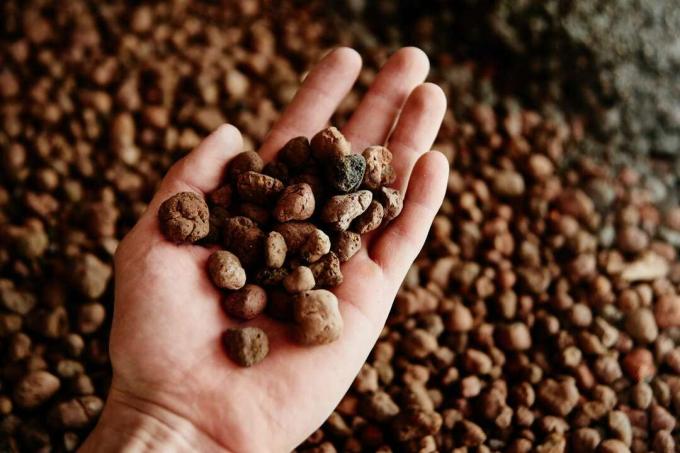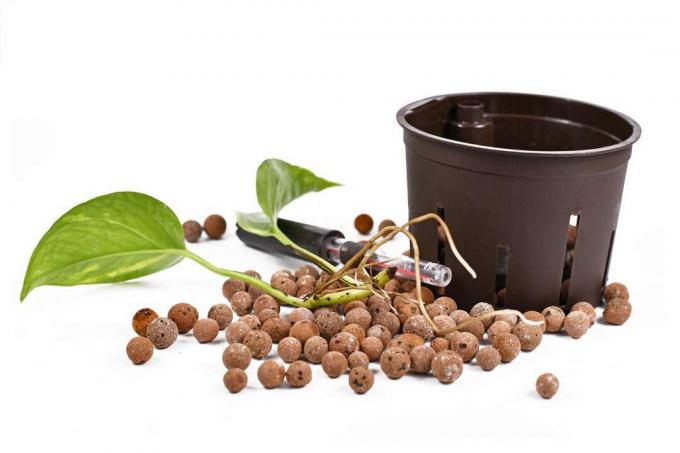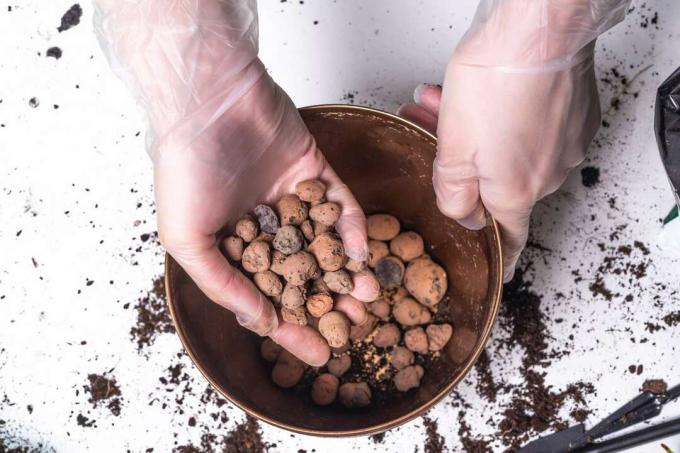What is expanded clay and how does it differ from clay flour and plant granules? What is the function of expanded clay in hydroponics? We reveal the different properties of the three clay materials and how you can use them correctly.

If you deal with hydroponics and suitable substrates, the topic of expanded clay and clay powder or plant granules quickly comes up. But what exactly is that? We will show you which material is suitable for hydroponics and how to set it up correctly and take care of it. We will also tell you how clay flour, clay granules or plant granules and expanded clay differ and how the clay products can be used.
contents
-
What is the difference between expanded clay, powdered clay and plant granulate?
- Properties and use of expanded clay
- Properties and use of plant granules
- Properties and uses of clay flour
-
Hydroponics with expanded clay in indoor plants
- What is hydroponics?
- Create hydroponics for indoor plants with expanded clay
- Water indoor plants in expanded clay correctly
- Properly fertilize indoor plants in expanded clay
-
Cultivate plants in plant granules
- Water indoor plants properly in plant granulate
- Properly fertilize indoor plants in plant granules
-
Other possible uses of expanded clay and plant granulate
- Expanded clay as drainage
- Expanded clay: use in the home
- Expanded clay: use in the garden
- Plant granules and clay flour: Use in potting soil
What is the difference between expanded clay, powdered clay and plant granulate?
Expanded clay, plant granules and clay powder are often used as synonyms. But that is not correct. In order to use the three useful materials correctly, it is important to know their properties:
Properties and use of expanded clay
The basic substance of expanded clay is, as the name suggests, clay. This is ground, granulated and then burned at 1200 °C. Only finely ground limestone is added as a release agent. The organic substances in the clay mass burn during the firing process and the balls swell due to the released carbon dioxide. This gives the expanded clay its typical round shape and the many gas pockets. The grain sizes 2 - 4 mm, 4 - 8 mm and 8 - 16 mm are produced. The pores are exclusively inside the balls, while the surface has closed pores.
For this reason, the beads can only absorb, store and release very little water and nutrients. However, capillary forces take effect on the rough outer layer, which transport water upwards. This effect is used in hydroponics. Smaller grits have a larger surface for a given pot volume, which means that more water rises, so the root area is wetter. The opposite applies to coarse grains.
A well-known problem with expanded clay is the high salt content: many inexpensive products have too high a sodium, fluoride and chloride content. Salt damage can occur when used in hydroponics. It is therefore important, on the one hand, to pay attention to material that is especially suitable for hydroponics. On the other hand, you should definitely rinse the balls with clear water before using them for the first time. In addition, expanded clay used for other purposes usually has a pH value that is completely unsuitable for plants.

Why is expanded clay so popular and versatile? The advantages of expanded clay are its purely natural origin, that it does not mold and that it does not collapse, change or degrade even after a long time. This makes it possible to use expanded clay both indoors in hydroponics and as an additive in planters or in the garden. Mixed into substrates and soils, it ensures a loose structure, good soil aeration and counteracts compaction.
By the way: Broken expanded clay is also available. By breaking up the balls, the porous interior is not only visible, but also usable: Broken expanded clay can absorb much more water than whole expanded clay.
Properties and use of plant granules
Like expanded clay, plant granules (such as Seramis®, Lechuza Pon® or BiLa-Ton®) are made from clay, a natural product. The natural clay is liquefied with water and then aerated to create an extremely high pore volume of up to 80%. The material is then dried, then broken into granules and sieved to the desired grain size. Here, too, the clay is fired at the end, but not quite as hot as in the production of expanded clay.
This method is used to make the surface of the fragments porous. This gives the plant granules a very high water absorption capacity and good nutrient storage. Incidentally, the red color of plant granules is not achieved with dyes. It is iron that has been oxidized when the clay was fired.
Due to its properties - high water and nutrient storage capacity - plant granules such as Seramis® and Co. cannot be described as hydroponic substrate. Rather, the plant granules try to mimic the properties of a soil: water and nutrients are present in the substrate, not exclusively in a water reservoir. In order to be usable for as many plants as possible, plant granules have an almost neutral pH value (6.2 to 7.5). For plants with special needs in terms of nutrients and pH, however, suitable ones are also used Plant granules offered: about particularly coarse screening for orchids or slightly acidic granules for Palm trees.

Properties and uses of clay flour
Clay powders such as bentonite are soil additives that can be used as additives in substrates but also on bed areas. Clay flour is dried and then coarsely ground clay. It allows to distribute the beneficial properties of clay minerals in powder form. These positive properties include the ability to store and provide nutrients, stabilize the pH value, and store water through swelling of the clay minerals. Another advantage is the formation of so-called clay-humus complexes, which ensure a more stable humus content in the soil. Clay powder is particularly suitable for improving sandy soils because it facilitates the build-up of soil humus. So it accelerates the increase in fertility humus-promoting management.
This distinguishes expanded clay from plant granules and powdered clay:
| expanded clay | plant granules | clay flour | |
|---|---|---|---|
| water-tank | Small amount | High | High |
| nutrient storage | Small amount | High | High |
| use | Hydroponic, additive to increase aeration in potting substrates | Complete indoor plant substrate, additive to increase nutrient and water storage | Additive to increase the water and nutrient storage in pot substrates and soil |
Hydroponics with expanded clay in indoor plants
There are many arguments in favor of hydroponics for houseplants. Hydroponics is the right choice for those who are not very good at cultivating plants in soil, are often away from home for a long time or simply enjoy something new.
What is hydroponics?
If plants are cultivated exclusively in an aqueous nutrient solution, this is called "hydroponics". Some of it is already used in the production of vegetable plants. However, the culture of indoor plants in a solid substrate such as expanded clay with a nutrient solution underneath is called hydroponics. This is exactly where the expanded clay comes into play. The roots can hold on to the expanded clay balls and at the same time absorb water and the nutrients dissolved in it. However, the roots do not hang in the water, otherwise they would begin to rot due to the lack of oxygen. The expanded clay, on the other hand, is surrounded by a thin film of water, which also transports the nutrients contained in the nutrient solution. This is how the plant roots get their essential nutrients with good ventilation.
Create hydroponics for indoor plants with expanded clay
If you are now interested in creating a hydroponic culture, you have two options: you can either buy a plant that is already planted in a hydroponic system from a specialist shop or build a system yourself invest. For starters, it is recommended to buy a ready-made system. If you already have some experience, you can transfer a plant from cultivation in soil to hydroponics. To do this, the root ball is carefully freed from the soil and the roots are washed out with water. Then you can put the bare roots in a special hydroponic pot. This consists of an inner pot, a waterproof outer pot and a water level indicator. You can then fill the inner pot with the expanded clay and add water to the outer pot. You can see the required amount on the water level indicator.
Tip: Even cacti (Cactaceae) and orchids (Orchidaceae) can be planted in hydroponics.

Water indoor plants in expanded clay correctly
How much water does my plant need and when should it be watered? With hydroponics, watering is made very easy. The water level indicator indicates an area in which the indicator needle should be located. When it drops below the minimum, it's time to water. Do not water beyond the maximum mark to prevent rot. Of course, different plants have very different needs when it comes to water supply. Here it is worth reaching for a houseplant guide so that you neither give too much nor too little water.
Properly fertilize indoor plants in expanded clay
When it comes to hydroponics, we don't actually talk about water at all, but always about a nutrient solution: the plants have to be provided with the nutrients they need via the water. Unlike soil, expanded clay does not provide any nutrients. To fill up the liquid in the cachepot, water is never used, but always nutrient solution, i.e. water with fertilizer dissolved in it. Make sure to use special fertilizers for hydroponics, because only these contain the nutrients in the right proportions.
Organic and mineral fertilizers are available for hydroponics. However, organic hydroponic fertilizers have the disadvantage that the container has to be cleaned more often. Otherwise foul-smelling biofilms will eventually build up on the expanded clay. When using mineral fertilizers, salts can build up over time. You should therefore pay attention to the exact dosage of the fertilizer according to the package insert, as this is important for the success of the system.

Tip: With both types of hydroponic fertilizer, we advise you to remove the plant with the inner pot from the hydroponic and clean the planter at least once a year. At the same time, you can rinse the plant in the inner pot under running water to remove salt or organic deposits.
Summary: hydroponics in houseplants
- The cultivation of plants with bare roots without soil in expanded clay: An inner pot with expanded clay stands in an outer pot with nutrient solution.
- Expanded clay serves as a holding facility for the roots and transports a film of nutrient solution via capillary forces on the outside of the expanded clay balls.
- The pouring amount of nutrient solution is determined by a water level indicator.
- Various indoor plants can be cultivated in hydroponics, but differ in their water and nutrient requirements.
Cultivate plants in plant granules
The cultivation of plants in plant granules such as Seramis® or Lechuza-Pon® is not a hydroponic culture because no nutrient solution is used. The plant is placed with the root ball in a waterproof pot that is about a third larger than the root ball. The pot is then filled with plant granules so that the roots are covered with a layer. Finally, a moisture meter is inserted into the soil ball.
Tip: The moisture meter can easily be confused with the hydroponic water level gauge, works but completely different: the moisture meter contains a special paper that changes color depending on the humidity changes. It indicates how moist the plant granules are at the moment. According to the manufacturer, the moisture meters should be replaced every 12 to 18 months.

Water indoor plants properly in plant granulate
As already explained above, plant granulate can store water very well and thus supply the root ball with water. Depending on the plant, this makes it possible to extend the watering interval. A moisture meter in the soil ball helps you to find the right time to water. When it turns red, it's time to water. The indicator then turns blue within about two hours. However, you don't have to follow the watering indicator extremely closely: it only changes color when the substrate tends to dry out. However, some plants only need water much later or even much earlier. With a little practice and experience, the watering indicator can also be safely omitted.
Properly fertilize indoor plants in plant granules
For fertilizing the plants in plant granules, we recommend specially tailored fertilizers, because normal fertilizers are often dosed too high. Always pay attention to the instructions in the package leaflet when adding fertilizer. The supply of phosphate to the plant is particularly important when cultivating in plant granules. The plant granules bind phosphorus, which is why attention should be paid to a high phosphate-nitrogen ratio. The use of pure phosphate fertilizers such as superphosphate can also prevent a deficiency over a long period of time.
Summary: Cultivate plants in clay granules
- The plant is planted with the soil ball in plant granules.
- The plant granulate stores a lot of water and nutrients and releases both to the root ball.
- The moisture indicator shows when the substrate is dry.
- You should fertilize regularly with special fertilizers to prevent deficiencies.
Other possible uses of expanded clay and plant granulate
Expanded clay in particular can be used in many different ways. But plant granules are also useful for purposes other than their original purpose.
Expanded clay as drainage
Expanded clay is ideal as a drainage layer in planters and flower boxes. Simply add a layer of layers to the jar before pouring in the soil. Such a layer protects against waterlogging and promotes the drainage of excess water, because very few plants like waterlogging. This prevents the development of root diseases and rot. An advantage of expanded clay is that it does not disintegrate, collapse and does not lose its effect as a drainage material over time: it is "structurally stable". You can use the expanded clay over a long period of time by simply catching and cleaning the beads the next time you repot.

Tip: If you place an old cloth over the drainage layer and then fill in the potting soil, you prevent the soil from mixing with the expanded clay and thus improve drainage.
Expanded clay: use in the home
Expanded clay can be used to locally increase the humidity in potted plants. But why can an increase in humidity be helpful? pests like spider mites, or thrips feel particularly comfortable in dry air in living rooms or in the greenhouse. To increase humidity, simply add some expanded clay to the planter or potted plant saucer. You can then add just enough water so that the expanded clay is not completely covered with water. If you now place the planter back in the planter or saucer, the roots will not come into direct contact with the water. This prevents rot from occurring. Due to the large surface area of the expanded clay, the water evaporates and causes increased local humidity. In addition, the higher humidity ensures that the soil dries out less quickly.
Tip: Finer expanded clay (2 - 4 mm) is useful for protection against fungus gnats: simply cover the surface of the ball of earth with a layer of clay balls about 2 cm thick. Fungus gnats are less interested in dry, rough soil surfaces. This also prevents mold and unpleasant odors from the potting soil.
Expanded clay: use in the garden
Weed growth can occur quickly, especially if you cultivate small trees in planters. Expanded clay can help you suppress weeds. To do this, simply add a 3 cm thick layer of expanded clay to the surface of the earth. In heavy, loamy soil outdoors, you can dig the planting hole a little larger than you would normally do when planting new plants and mix the substrate with expanded clay to fill it. This gives the soil structure and loosens it up.
Plant granules and clay flour: Use in potting soil
Plant granules such as Seramis® and BiLa-Ton® store, as well as clay flour, moisture and nutrients. They can also be used as an additive for potting soil if it needs to stay moist longer and be able to store more nutrients. Some plants such as the Chinese hibiscus (Hibiscus rosa sinensis) or myrtle (Myrtus communis), sword fern (Nephrolepis) and nest fern (Asplenium nidus) need always moist soil. You will benefit greatly if the potting soil used is mixed with some plant granules.
To match a modern method of plant cultivation exotic houseplants very good. We present some particularly exciting specimens in our special article.
